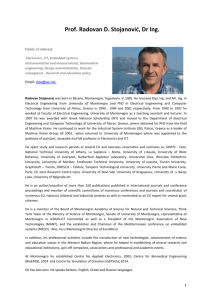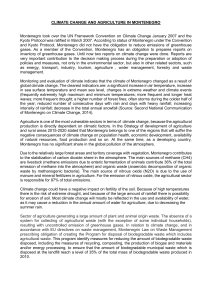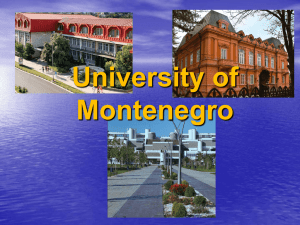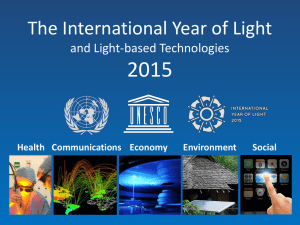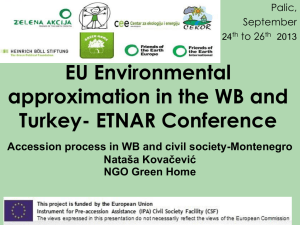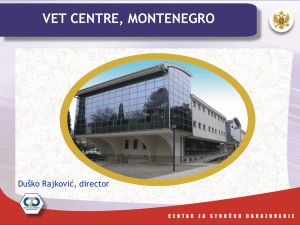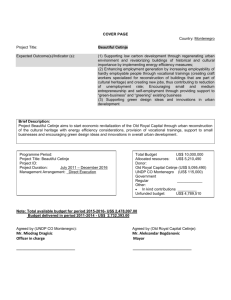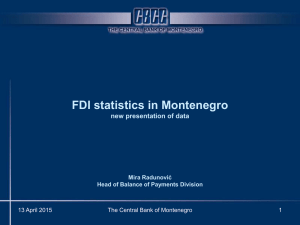projects in energy sector
advertisement
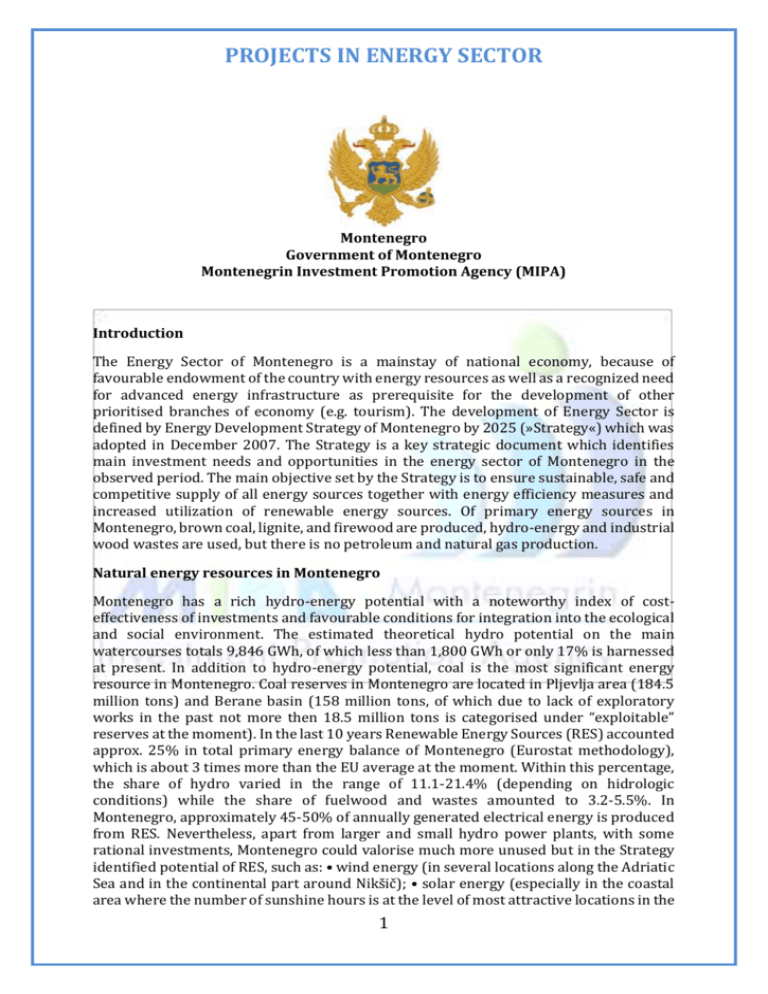
PROJECTS IN ENERGY SECTOR Montenegro Government of Montenegro Montenegrin Investment Promotion Agency (MIPA) Introduction The Energy Sector of Montenegro is a mainstay of national economy, because of favourable endowment of the country with energy resources as well as a recognized need for advanced energy infrastructure as prerequisite for the development of other prioritised branches of economy (e.g. tourism). The development of Energy Sector is defined by Energy Development Strategy of Montenegro by 2025 (»Strategy«) which was adopted in December 2007. The Strategy is a key strategic document which identifies main investment needs and opportunities in the energy sector of Montenegro in the observed period. The main objective set by the Strategy is to ensure sustainable, safe and competitive supply of all energy sources together with energy efficiency measures and increased utilization of renewable energy sources. Of primary energy sources in Montenegro, brown coal, lignite, and firewood are produced, hydro-energy and industrial wood wastes are used, but there is no petroleum and natural gas production. Natural energy resources in Montenegro Montenegro has a rich hydro-energy potential with a noteworthy index of costeffectiveness of investments and favourable conditions for integration into the ecological and social environment. The estimated theoretical hydro potential on the main watercourses totals 9,846 GWh, of which less than 1,800 GWh or only 17% is harnessed at present. In addition to hydro-energy potential, coal is the most significant energy resource in Montenegro. Coal reserves in Montenegro are located in Pljevlja area (184.5 million tons) and Berane basin (158 million tons, of which due to lack of exploratory works in the past not more then 18.5 million tons is categorised under “exploitable” reserves at the moment). In the last 10 years Renewable Energy Sources (RES) accounted approx. 25% in total primary energy balance of Montenegro (Eurostat methodology), which is about 3 times more than the EU average at the moment. Within this percentage, the share of hydro varied in the range of 11.1-21.4% (depending on hidrologic conditions) while the share of fuelwood and wastes amounted to 3.2-5.5%. In Montenegro, approximately 45-50% of annually generated electrical energy is produced from RES. Nevertheless, apart from larger and small hydro power plants, with some rational investments, Montenegro could valorise much more unused but in the Strategy identified potential of RES, such as: • wind energy (in several locations along the Adriatic Sea and in the continental part around Nikšič); • solar energy (especially in the coastal area where the number of sunshine hours is at the level of most attractive locations in the 1 PROJECTS IN ENERGY SECTOR Mediterranean zone: 2,000- 2,500 h/year); • biomass and plant waste (mainly in the North, considering that Montenegro has an annual yield of wood between 850,000 m3 and 1,060,000 m3 ); • municipal solid waste (which in Montenegro amounts to 200,000 250,000 tons/year). Based on previously conducted research, the total petroleum core potential (potential geological reserves) has been determined in two separate offshore zones in Montenegro to the amount of 12.5 x 109 tons, i.e. 7 billion barrels of petroleum and 425 billion m3 of natural gas reserves. Numerous complex and additional timeconsuming exploratory works are required to define commercial cost-effectiveness of exploitation. Projects 1. Name of the Project Exploitation of coal in “Maoce” basin, Pljevlja municipality. 2. Description of the project Maoce basin is located in the north-east part of Montenegro, with the air distance of 15 km from Pljevlja. The Maoče Basin is located in the Neocene basin at an altitude of 880- 980 meters in the mountain area. An average annual precipitation (snow and rain) amounts to 900 mm. An average annual temperature is 7°C and there are 40-50 cold days (air temperature below 0°C) during the year. The investors are expected to finance, open, exploit and perform recultivation of the coal mine ‘’Maoče“, and to finance, build and operate the Thermal Power Plant ‘’Maoče’’, as a single business entity. The Project ‘’Maoče’’ refers to the exploitation of coal, conditioned by the construction of a thermal power plant with an estimated capacity of 500 MW. Coal reserves in the basin of Maoče are geological (123 million t) and exploitation (109.9 million tons). The annual production potential is 3,500 GWh. 3. Status of the project • The Government of Montenegro will award a concession for the exploitation of coal from the basin of Maoče and the construction of a thermal power plant of the estimated capacity 2 PROJECTS IN ENERGY SECTOR of 500 MW (2k250MW), based on the current reserves of coal and the thermal power plant life cycle; • The term of the concession contract is 45 years, with a possibility of extension in accordance with the law; • Concession fees for the exploitation of coal will be calculated as a percentage of revenues from the sales of electricity; • The proposed model of business operations is DBOMR (Design Build Operate Maintain Recultivate). Note: Regarding the energy sector, Montenegro is characterized by the radial structure of the three voltages (400 kW, 220 kW and 110 kW) and connections with Kosovo (400 kW), Serbia (220 kW), Albania (220 kW) and Bosnia and Herzegovina (over 400 kW, 220 kW and 110 kW overhead power lines). The new 400 kW transmission line to Albania is in preparation. A submarine cable with the transmission capacity of 1,000 MW is planned between Montenegro and Italy. Part of it is already built in Sumitomo electric factory in Japan. Energy sector features Montenegro energy balance was featured by a significant shortage of electricity which resulted in import of electricity. Montenegro Energy Development Strategy until 2025 (mid-term scenario) estimates the electricity consumption growth at the rate of 1.22% meaning that by 2025 the consumption will reach around 5.800 GWh. 3 PROJECTS IN ENERGY SECTOR 1. Name of the Project Exploration and production of hydrocarbons in the waters of Montenegro (Oil and Gas) 2. Description of the project The Government of Montenegro in cooperation with Norwegian experts regulated the field of research and production of oil and gas. In August 2010, The Law on the Research and Production of Hydrocarbons was adopted (in full compliance with relevant EU directives). Government may award a concession contract for exploration to one or more bidders; The concessionaire is obliged to submit a report on the results of exploration to the Government within six months from the date of completion of the works set out in the work plan; The subject of the concession agreement for exploration may be the right to Geological, geophysical or other detailed examination of the earth’s crust, except for drilling wells in order to determine the structural and tectonic features of the environment and estimate the presence of hydrocarbons; The production includes the operation of extracting hydrocarbons from the reservoirs, their separation and the initial processing and preparation of oil or gas for the production, transportation and storage, gas liquefaction at the reprocessing facilities, as well as bringing the hydrocarbons to the terminal. A large number of foreign companies expressed interest and willingness to invest in projects of oil and gas in the Montenegrin coast. 3. Status of the project First Bid Round– block with submitted bids The Government of Montenegro has received bids from 6 companies to the Public Invitation to Apply for Award of Hydrocarbons Production Concession Contract Offshore Montenegro as of the deadline for submission of bids on 15 May 2014 until 15:00 UTC+1. 4 PROJECTS IN ENERGY SECTOR 1. Name of the project TAP-IAP (Ionian-Adriatic Pipeline) 2. Description of the project Trans Adriatic Pipeline (TAP) is a gas pipeline that via Greece, Albania, the Adriatic Sea and Italy's Puglia area enables transport of gas from the the Caspian region to Western Europe. TAP will open the Southern Corridor gas supplies to Europe and will be open to all sources of gas, not only for the supply of gas from the Azerbaijan's Shah Denis gas field. In December 2013, in Baku, Azerbaijan, final decision is made about investing in this project. Through diversification of sources of gas supply, this project will improve the security of supply of 5 PROJECTS IN ENERGY SECTOR Europe. The Ministry of Economy delivered draft of feasibility study and accompanying documents, as well as the draft study of impact on environment to relevant state institutions and local governments for an opinion. The feasibility study will also include a proposal for the development of the business model of the project. 3. Status of the project Untill the end of 2014 is expected the definition of the necessary conditions for the realization of the project (the region, financing, business model, and spatial planning assumptions). Also, finishing a master plan for gasification of Montenegro. 1. Name of the project Building of 2nd block of TPP Pljevlja 2. Description of the project 31st of December 2013, in the Ministry of Economy were publicly opened bids for the project. 9 companies submitted their bids. Companies from China: China Machinery Engineering Corporation (CMEC), China Gezouba Group International Engineering Company (CGGC), TBEA Shenyang Transformer Group Co.Ltd, Powerchina - Hubei Electric Power Survey & Design Institute, China nationaly Electric Engineering Co. Ltd., CNEEC as well as companies from Europe: Škoda Praha, Czech Republic; Istroenergo Group - IEG, Slovakia; Mixed consortium of companies from Poland and rusata Overseas, Russia. The new unit shall have power in the range 220-300MW, at location of the existing units of TPP "Pljevlja". The new block will be constructed with the use of latest technology in compliance with the latest requirements for environmental protection according to EU norms. The plan for the project is implementation through an interstate agreement. The shortlisted are four companies: Škoda Praha, Powerchina Hubei Electric Power Survey & Design Institute, Istroenergo Group IEG Slovakia-SES Tlmace and China Machinery Engineering Corporation (CMEC). 6 PROJECTS IN ENERGY SECTOR 3. Status of the project Until the end 2014 signing of the contract with the best bidder is expected. Ensuring spatial planning assumptions for the further implementation of the project, also defining an institutional mechanism which thus enables the efficient implementation of the project between RUP and EPCG. Defining an interstate agreement and start of the project is expected at the same time. 1. Name of the project HPP'S MORACA AND KOMARNICA 2. Description of the project So far only about 20% of the total hydropower potential has been used. HPP Komarnica - possibilities for investment in two power generators of 168 MW, with annual production of 232 GWh. Overall investment is estimated at the level of some €182.8 mil. in 6 years. HPP Morača - basic Technical Design encompases construction of four hydro-power plants with total installed power of some 238.4 MW and an average annual generated electric power of some 721 GWh. Small hydro power plants are up to 10 MW. Up to now, concessions were awarded for 25 small hydro power plants. The subject matter of the concession is the design, construction, exploitation and maintenance of small hydro power plants at water courses. The duration of the concession shall be fixed for all water courses and it shall be for 30 years. This period shall be calculated from the day of creating of all necessary conditions for the issuance of urban planning and technical requirements. 3. Status of the projects Regarding Moraca HPP research work is completed, detailed spatial plan, assessment of environmental impacts for the project, which envisages four hydropower plants on the Moraca River, as well as tender documents. Up to now, concessions were awarded for 25 small hydro power plants. Tenders for streams that have not been assigned during the previous tender procedures are expected during next year. 7 PROJECTS IN ENERGY SECTOR 1. Name of the project Wind power plants Krnovo and Mozura 2. Description of the project Wind farm on the site Krnovo / VE Krnovo installed capacity of 72 MW. The contract of lease of land and construction of the wind farm at the site Krnovo (Municipality of Niksic, Šavnik and Plužine) was concluded on August 5, 2010 with the consortium "MHI-IVICOM Consulting GmbH" Wind farm on the site Možura / Možura wind power capacity to 46 MW. The contract of lease of land and construction of the wind farm at the site Možura (Municipality of Ulcinj and Bar) was concluded on 5 July 2010 with a consortium of "Fersa Energias Renovables" SA Spain and "Čelebić" DOO Podgorica. 3. Status of the projects Issuance of building permits and the commencement of works are expected in next period. For new investors there is opportunity to explore new locations. 1. Biomass potential 8 PROJECTS IN ENERGY SECTOR Estimate of energy potential of biomass is focused on the most important resources: forestry, wood-processing industry residual, agriculture. According to this the main biomass potential for generation can be represented with following proportion: - forests and forested land 721,298 or 52.2% from total Montenegro area - agricultural land 516,219 ha or 37.4% from total Montenegro area * excluded from biomass potential 143,683 or 10.4% 10.40% 52.20% Forests and forested land Agricultural land 37.40 % Excluded from biomass potential Image 3: Estimate of energy potential 6.1. Forestry Forests and forested land are occupying an area of 721,298 ha and represent 52.2% of total Montenegro area and represent the most significant energy potential for Montenegro. Image 4: Forests, storage of biomass in industry There were 427 companies registered for wood-processing in the Commercial court in 2007. Forestry sector is especially interesting for the energy systems that use biomass as a fuel. Table 5. Area, wood mass, growth, forest status 9 PROJECTS IN ENERGY SECTOR Ownership Area ha Wood mass m³ bdm State forests and forested land Private forests and forested land Total: Growth m³ bdm Forest status m³ bdm 551,015 62,233,000 1,255,000 942,489 170,283 8,407,000 176,000 176,695 721,298 70,640,000 1,431,000 1,119,184 According to the data in Table 5 it can be concluded that forest status is balanced in the range of 78,20% from annual growth. The most recent estimation of high and sucker government-owned forests shows a high production potential of the most valuable forest lands in Montenegro. Table 6. High and sucker government-owned forest areas, present growth, potential growth Ownership High government forests Sucker government forests Total: Area ha 200,571 Present growth m³ Potential growth m³ bdm bdm By ha On total By ha On total area area 4.98 998,843 9.03 1,811,156 35,703 2.19 78,189 6.5 232,069 236,274 4.56 1,077,032 8.64 2,043,225 Average weight – 1m³ = 0,7 t • The fact that on the most valuable forested land the growth of wood mass is 8.64 m³/yr shows that forests in Montenegro have higher, even double production and energy capacity than they do today. This kind of non proportionality between current status and future potential calls for use of the most efficient forest technologies. • Wood biomass useful for energy generation can be estimated as a theoretical value from the forest status presented in Table 5 in case that the whole roundwood is processed in Montenegro, through primary or final processing. 6.1.1. Structure and quantity of wood biomass Forestry biomass suitable for energy generation is presented in Table 7. 10 PROJECTS IN ENERGY SECTOR Table 7. Forest status, technical roundwood, space roundwood, forest residuals, tree crust Gross Technica Space Forest Tree Total forest l roundwoo residual crust energygeneratin Area status roundwo d s g biomass m³ od m³ m³ m³ m³ m³ m³ t bdm Montenegr 1,119,1 447,673 458,865 167,878 44,7 671,51 402,29 o 8 6 0 0 4 7 Average weight – 1m³ = 0.7 t Stumps and roots are not accounted for considering orographic conditions of Montenegro forests. 6.2. Wood-processing industry Wood-processing industry in Montenegro has 427 registered companies that during their processes generate significant wood biomass. 6.2.1. Structure of residual from primary wood-processing Table 8. Technical roundwood, commercial product, sawdust, large residual and the rest Area Montenegro Technical roundwood Commercial product m³ m³ 447,673 246,220 Large Sawdust residual m³ The rest m³ 107,442 Total energy potential m³ m³ 62,674 31,337 Additional residual (tree crust 14% from technical roundwood) Total residual t 201,453 62,674 264,127 158,476 Average weight – 1m³ = 0.7 t 6.2.2. Structure of residual from final wood-processing Table 9. Secondary residual, final residual, other residual Area Cut wood % Commercial product Secondary residual m³ m³ 11 Final residual m³ Other residual m³ Total m³ t PROJECTS IN ENERGY SECTOR Montenegro 246,220 86,177 140,345 7,337 12,311 160,043 96,026 Average weight – 1m³ = 0.7 t 6.3. Main indicators of primary production of fast-growing types of trees for energy use Montenegro has good land condition for growing plantations of fast-growing trees that can be used for energy generation. The most suitable areas for such growth are: the lowest areas of Niksic flatland (Bara budoška i Slivlje); area on the riverside of river Donja Zeta; area around Skadar lake (from Božaj to Karuča); area on the riverside of river Tara (from Mataševo to river Bistrica in Mojkovac municipality); area on the riverside of river Lim (from Murina to Brodarevo). Table 11. Location, area, generation Growth m³/god Location Nikšić Donja Zeta Skadar lake Tara Lim Total Area ha m³/g Raw wood Total annual t per year 1,500 - - - 400 - - - 10,000 - - - 500 - - - 1,000 - - - 13.400 50 670,000 455,600 Detailed feasibility study would be needed in order to give more information on the possibility of growth of fast-growing plantations for energy use in these areas. Image 6: Plantation of fast-growing trees 6.4. Agriculture Main bioenergy resources from agriculture are viticulture and fruit-growing. The agricultural land used for farming and growing wheat are not quantified cause they are small and not concentrated in one area. 12 PROJECTS IN ENERGY SECTOR 6.4.1. Viticulture The cutting residuals from vineyards are traditionally burnt. The study shows that one kilogram of residuals from grape trees equals the energy value of one kilogram of fossil fuel. Therefore, the cutting residuals from vineyards can be used for energy generation. 6.4.1.1. Cutting residual Table 12. Area, production of cutting residual Subject Area ha Number of grape trees Kg of cutting mass per grape tree Total t State-owned 2,310 8,914,298 - - Privately owned 3,000 9,252,013 - - Total 5,310 18,166,311 1.75 31,791 Source: Annual statistics 2009; Vineyards 13.jul. d.o.o. Podgorica 6.4.1.2. Husk residual Husk residual that is left over during production of liquor has a significant energy value. Energy valorization of husk residual can improve general energy efficiency of grape growing and wine making business. Table 13: Amount of husk from grape trees, energy value Subject Number of grape trees Kg of husk per grape tree Total t/g of husk Husk residual t/g Dry husk residual t/g Privately owned 9,252,013 1.99 16,557 - - State-owned 8,914,298 3.21 27,432 - - 18,166,311 2.61 43,989 35,100 15,795 Total Source: Annual statistics for Montenegro 2009; own research 13 PROJECTS IN ENERGY SECTOR Image 8: Vineyards of “Plantaze 13. Jul” Podgorica 6.4.1.3. Olive yards Montenegro has a large number of olive trees. From the olive trees, specifically from the process of oil making, a significant amount of mass can be collected that can be used for energy value. Table 14. Amount, energy value Subject Number of trees Total t/g product Kg per tree of product Husk t/g Dry husk t/g Privately owned 429,900 2,401 5.7 2,089 1,044 State-owned 18,500 -- - - - 2,089 1,044 Total 448,400 2,401 5.7 Source: Annual statistics fro Montenegro 2009; own research Image 9: Olives and olive tree, Ulcinj 6.5. Synthesis of bioenergy structure Synthesis of bioenergy potential is presented by sectors in Table 15. Table 15: Quantity and energy value by sector Sector Units 14 Quantity t Energy value KWh/t Σ GWh PROJECTS IN ENERGY SECTOR Forestry- 25% moisture t 470,057 3,085 1,450 Wood-processing industry -12% moisture t 298,306 4,000 1,193 Forest cultured plantations- 25% moisture t 455,600 3,000 1,367 Residuals from viticulture -25% moisture t 31,791 3,000 95 Husk from grape trees -10% moisture t 15,795 5,500 87 Husk from olive trees -10% moisture t 1,044 5,500 6 Total t 1,272,593 3,300 4,200 • Montenegroo bioenergy potential of 4.200 GWh is 1.5 times greater than the current electrical energy production (2.800 GWh) which goes to show that the green energy is the energy of the future. 7. Market Wider use of biomass for energy use currently practically does not exist in Montenegro. Some of the wood-processing industry companies use biomass for production of energy for selfuse. The residual wood from hardwood is traditionally used for heating in households in heaters. Small production of briquettes in some wood-processing companies is used in local markets. Significant use on the local market is expected with the increase in use of biomass for energy generation (pellets, briquettes, electricity). In order for this to happen technology transfer needs to happen first. Considering that the need for energy from biomass from point of view of its price, green energy, sustainability is increasing, the use of biomass energy on the local as well as regional and wider markets in inevitable. This is the main condition for pushing the biomass as energy product in the future. 15
